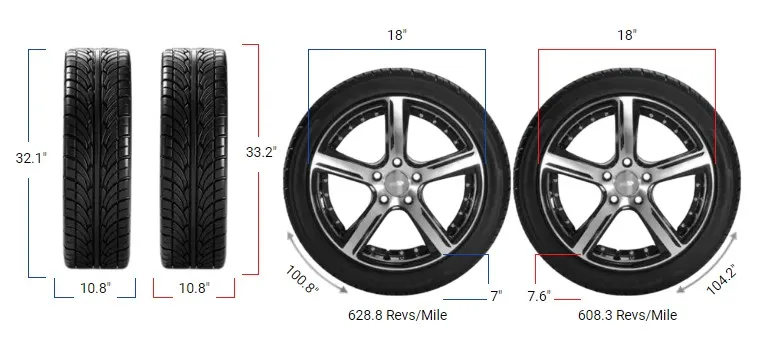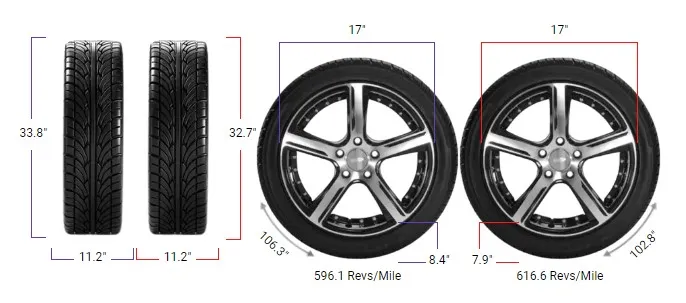Tire Size 225/40r18 vs 245/40r18

Switching from 225/40R18 to 245/40R18 can enhance certain aspects of your driving experience, but it comes with its trade-offs. Understanding how these changes impact performance both on-road and off-road is crucial.
- Wider tires provide better grip and handling, especially during cornering.
- Slight increase in ground clearance offers minimal off-road protection.
- Larger tire width may reduce fuel efficiency due to higher rolling resistance.
- The broader profile gives the car a more aggressive and sportier appearance.
- Increased sidewall height slightly improves ride comfort over rough surfaces.
- Speedometer readings will be slightly off, showing a slower speed than actual.

Fitment Guide
For this case, the diameter of the 225/40R18 tire is 25.09 inches (637.2 mm), while the 245/40R18 tire has a slightly larger diameter of 25.72 inches (653.2 mm), which translates to a 2.5% increase.
Since the difference remains under the 3% threshold, the swap is generally acceptable without major modifications. However, attention should still be paid to fitment clearances and potential rubbing on tight turns.
On-Road Impact and Off-Road Impact
When it comes to switching tires, on-road and off-road performance will see changes in areas like ground clearance, gas mileage, aesthetic appeal, ride comfort, and speedometer accuracy. Here’s a breakdown of these key factors:
Ground Clearance
The slightly increased diameter of the 245/40R18 tire will raise your vehicle’s ground clearance by 0.31 inches (8 mm).
While this is a marginal difference, it can offer better protection over rough roads. On paved surfaces, however, the change is barely noticeable.
Gas Mileage
With a wider footprint, the 245/40R18 may cause a minor decrease in fuel efficiency. More tire surface area means higher rolling resistance, so expect a slight drop in gas mileage, especially on highways. However, for everyday city driving, the difference might be negligible.
Aesthetic Look
Visually, the 245/40R18 tire offers a wider and sportier appearance. For enthusiasts, this more aggressive look can be a big draw, particularly for cars with performance aspirations.
The additional width fills out the wheel wells more effectively, giving the vehicle a more planted stance.
Ride Comfort
The larger sidewall height of the 245/40R18 tire (3.86 inches compared to the 3.54 inches of the 225/40R18) adds a small cushion of extra rubber between the road and your car.
This extra cushion may slightly improve ride comfort, especially on rougher roads. However, because the increase is modest, the improvement may not be very pronounced.
Speedometer Accuracy
Since the 245/40R18 tire is larger in diameter, it will affect your speedometer readings. For example, when your speedometer reads 20 mph, you’ll actually be traveling at 20.5 mph.
This 2.5% difference isn’t drastic but could become more significant at higher speeds. For most drivers, this discrepancy is negligible, but it’s important to be aware of it.
Durability & Wear
Wider tires like the 245/40R18 may have better durability because the extra width distributes the vehicle’s weight over a larger area. This reduces the pressure on each part of the tread and can potentially lead to slower wear.
However, increased width also means greater exposure to rough road conditions, which could lead to faster wear in more aggressive driving environments.
225/40r18 vs 245/40r18
| Feature | 225/40R18 | 245/40R18 | Difference |
|---|---|---|---|
| Diameter inches (mm) | 25.09 (637.2) | 25.72 (653.2) | 0.63 (16) +2.5% |
| Width inches (mm) | 8.86 (225) | 9.65 (245) | 0.79 (20) +8.9% |
| Circumference inches (mm) | 78.81 (2001.82) | 80.79 (2052.09) | 1.98 (50.27) +2.5% |
| Sidewall Height inches (mm) | 3.54 (90) | 3.86 (98) | 0.31 (8) +8.9% |
| Revolutions per mile (km) | 803.94 (499.54) | 784.25 (487.31) | -19.69 (-12.24) -2.4% |
| Speedo Reading | 20 mph (32.19 km/h) | 20.5 mph (33 km/h) | +0.5 mph |
Difference Between 225/40r18 and 245/40r18
The main difference between 225/40R18 and 245/40R18 tires is their width. The 245/40R18 tire is 0.79 inches wider, providing better road grip but potentially affecting fuel efficiency.
Can I Use 245/40r18 Instead of 225/40r18?
Yes, you can use 245/40R18 instead of 225/40R18. The diameter difference is within the recommended 3% range, so the switch is generally safe without requiring modifications.
How Much Taller Is a 245/40r18 Tire Than a 225/40r18?
The 245/40R18 tire is approximately 0.63 inches taller than the 225/40R18, which slightly raises the vehicle’s ground clearance and may affect speedometer accuracy.
How Much Wider is a 245/40r18 Tire Than a 225/40r18?
The 245/40R18 tire is 0.79 inches wider than the 225/40R18, which enhances handling and traction, especially during cornering, but may slightly reduce fuel efficiency.
Our Observation
Switching from 225/40R18 to 245/40R18 can have a positive impact, especially for drivers looking for better road grip, improved aesthetics, and slightly enhanced ride comfort.
The wider tire gives the vehicle a more planted and aggressive stance, which is especially appealing for those focused on performance.
On the other hand, the added width may come at a small cost to fuel efficiency and slightly skew speedometer accuracy, although these differences are relatively minor.
On the on-road front, the change is largely beneficial, providing better handling and a more robust look. For off-road applications, the marginal increase in ground clearance is helpful but not substantial enough to make a significant difference in rough terrain.
The key takeaway is that this tire swap makes sense for drivers who prioritize style and handling, but those focused on fuel savings may want to stick with the original size.



